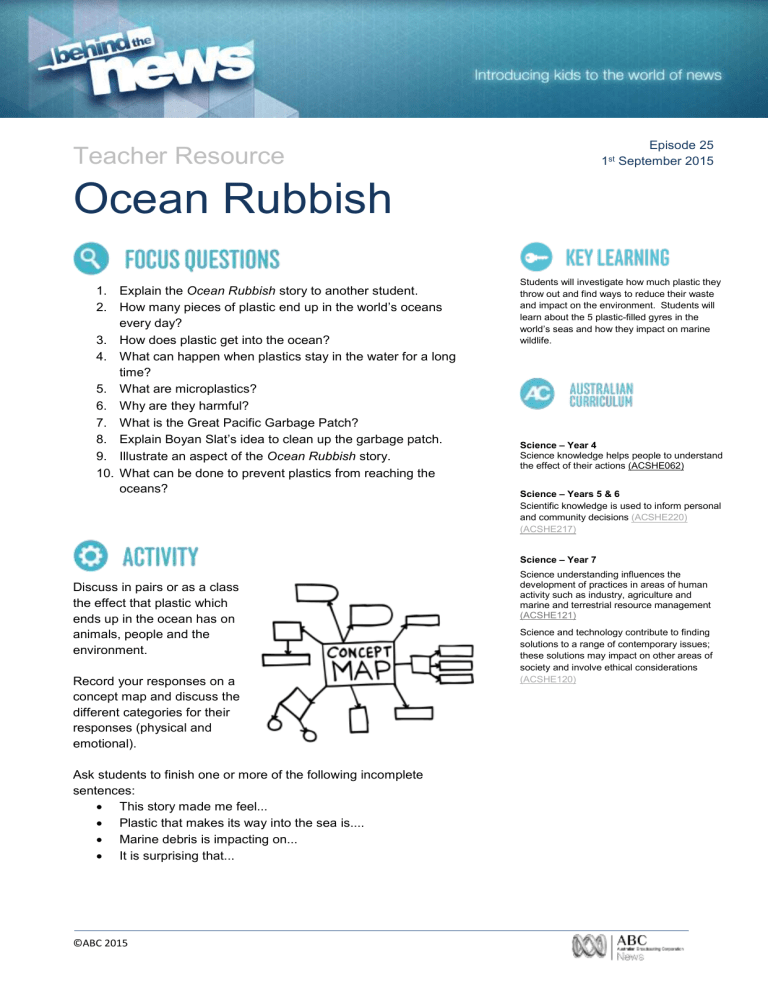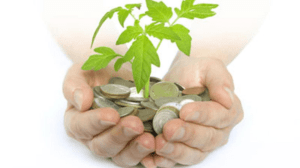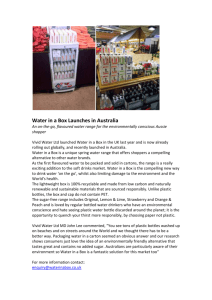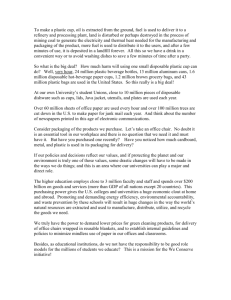WORD - ABC

Teacher Resource
Ocean Rubbish
1. Explain the Ocean Rubbish story to another student.
2. How many pieces of plastic end up in the world’s oceans every day?
3. How does plastic get into the ocean?
4. What can happen when plastics stay in the water for a long time?
5. What are microplastics?
6. Why are they harmful?
7. What is the Great Pacific Garbage Patch?
8. Explain Boyan Slat’s idea to clean up the garbage patch.
9. Illustrate an aspect of the Ocean Rubbish story.
10. What can be done to prevent plastics from reaching the oceans?
Discuss in pairs or as a class the effect that plastic which ends up in the ocean has on animals, people and the environment.
Record your responses on a concept map and discuss the different categories for their responses (physical and emotional).
Ask students to finish one or more of the following incomplete sentences:
This story made me feel...
Plastic that makes its way into the sea is....
Marine debris is impacting on...
It is surprising that...
©ABC 2015
Episode 25
1 st September 2015
Students will investigate how much plastic they throw out and find ways to reduce their waste and impact on the environment. Students will learn about the 5 plastic-filled gyres in the world’s seas and how they impact on marine wildlife.
Science – Year 4
Science knowledge helps people to understand the effect of their actions (ACSHE062)
Science
– Years 5 & 6
Scientific knowledge is used to inform personal and community decisions (ACSHE220)
(ACSHE217)
Science – Year 7
Science understanding influences the development of practices in areas of human activity such as industry, agriculture and marine and terrestrial resource management
(ACSHE121)
Science and technology contribute to finding solutions to a range of contemporary issues; these solutions may impact on other areas of society and involve ethical considerations
(ACSHE120)
Topics of inquiry
Students will determine a focus for their ocean rubbish inquiry within an area of interest, for example, make a prediction or develop a key question.
What is a gyre? Explore the 5 plasticfilled gyres in the world’s seas and how they impact on marine wildlife.
What is meant by the term ‘travelling trash’? Explore the journey of plastic into our oceans. Watch this TED-Ed video to find out what really happens to the plastic you throw away.
What types of study and research are scientists doing to help protect marine ecosystems and wildlife? Explore and explain one study in depth.
What might happen if we don’t look at the marine debris problem? Think about the responsibility of individuals, communities and the government.
Why should we protect our oceans? Write a persuasive piece of writing explaining your reasons.
Marine debris is a significant Australian and global issue causing negative ecological, economic and social impacts. Explore and explain these impacts.
Awareness challenge – Are you waste wise?
For one week students (and teacher) will keep a diary to document the amount of plastic they throw away at school and at home on a daily basis.
Class brainstorm
Before starting this challenge, brainstorm the types of plastic you throw away on a daily basis. Share your ideas as a class recording your responses on your classroom whiteboard. For example, cling wrap from your school lunch, plastic shopping bags, straws, water bottles, chip packets and other food packaging.
Audit your waste
On a daily basis, collect and record all your waste that is plastic, including the weight. At the end of the week add up how many pieces of plastic you threw out and the combined weight. Plot your results on a bar graph.
Day
What plastic did you throw away?
For example, cling wrap, food packaging, straws, drink bottles
Number of items Weight of plastic
Monday
Tuesday
Wednesday
Thursday
Friday
Analyse your results and respond to the following:
What surprised you about the results?
Identify the best areas for improvement. How could you reduce the amount of plastic you throw away?
©ABC 2015
Reduce your waste
Do your part to make a change and challenge yourself by going plastic-free for a day or a week.
Think of ways that you can avoid using plastic that you would normally throw away. How can you reduce, reuse, recycle or upcycle plastic? For example, use paper bags to wrap you lunch, purchase milk and juice in cardboard and shop at your local farmers market to avoid pre-packaged food.
Did you find this challenge difficult? Why or why not? Explain.
What plastic-free alternatives did you use during the challenge? Describe.
How has this challenge impacted on your thinking?
Poster design
In small groups or as a class think about the effect that plastic pollution in our oceans has on people, animals and the environment. Record your responses in a mind map, with the sentence “Plastic pollution in our oceans is...” written in the middle.
difficult to cleanup because it breaks down into really small pieces (micro plastics)
killing marine life – species are getting tangled in plastic and are eating the plastic
threatening marine ecosystems
costing a lot of money to cleanup
everyone’s problem (consumers and producers)
affecting the food we eat and our health
making our beaches and oceans dirty which may affect tourism
Design a poster which illustrates one or more of the ways that plastic pollution in our oceans affects people, animals and/or the environment. Display your artworks to celebrate seaweek and raise awareness about the issue.
Upcycling
Watch BtN’s Upcycling Kids story and then talk about upcycling as a class. Have you ever turned your rubbish into treasure? Describe your creations to other students in your class. What materials did you use?
As a class list the benefits of upcycling. Here are some suggestions:
reduces the amount of waste and therefore landfill
reduces the need for production using new or raw materials (therefore reduces air pollution, water pollution, greenhouse gas emissions)
unique, one of a kind products
saves money – for example you could upcycle your clothes into new designs
uses your creativity
Experiment with upcycling using recycled materials collected at home and at school.
©ABC 2015
ABC News – Researchers sample giant rubbish vortex in Pacific Ocean as part of global, clean-up proposal http://www.abc.net.au/news/2015-08-24/researchers-sample-giant-oceanic-rubbish-vortex/6720802
TED Ed Lessons – What really happens to the plastic you throw away? http://ed.ted.com/lessons/what-really-happens-to-the-plastic-you-throw-away-emma-bryce
5 Gyres – What is the issue? http://www.5gyres.org/what_is_the_issue/the_problem/
Behind the News – Plastic Oceans http://www.abc.net.au/btn/story/s3591476.htm
Behind the News – Take 3 http://www.abc.net.au/btn/story/s3875973.htm
Adrift – Marine Plastics Interactive http://www.adrift.org.au/map?lat=-19&lng=-71.4¢er=133.3&startmon=Jan
©ABC 2015








